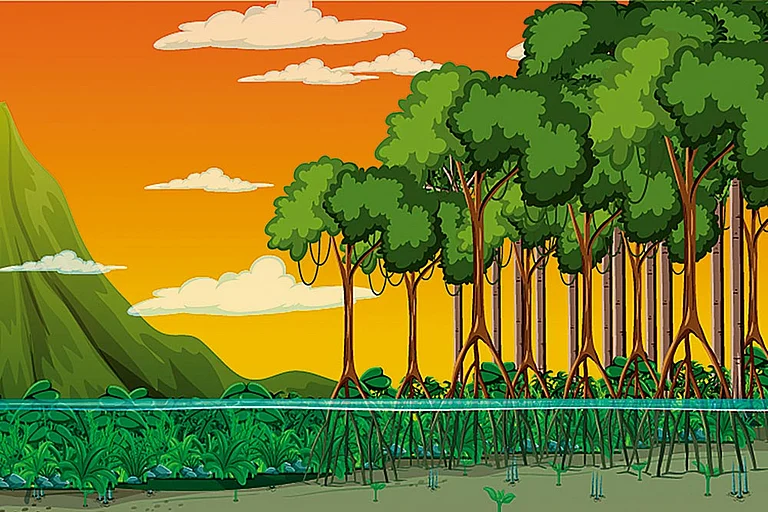Tesla has earned over $10 billion from carbon credits, cushioning revenue as EV sales fluctuate globally.
Uttar Pradesh is paying farmers in advance for future carbon credits from tree plantations to encourage reforestation.
Critics argue carbon credits delay real emission cuts and risk greenwashing while their voluntary market value keeps falling.
From Earning $10Bn For Tesla to India’s Agroforestry Experiment—What Are Carbon Credits & Why They Matter
Carbon credits, designed to balance emissions, have become both a financial lifeline for global companies like Tesla and an incentive tool for farmers in India, raising questions about their effectiveness as true climate solutions
Tesla has earned over $10bn by selling carbon credits to companies that exceed emission limits since 2017, according to Carbon Credits, a carbon market news website. In effect, these credits act like legal passes to pollute the environment which come at a cost to companies.
What are Carbon Credits?
Under the Paris Agreement signed by 195 members of the United Nations Framework Convention on Climate Change in 2016, governments began limiting corporate emissions. One carbon credit allows a company to emit one tonne of carbon dioxide. If a company exceeds this limit it must either pay a penalty or buy credits from greener companies that emit less than their limit.
India’s Carbon Credit Push
In Uttar Pradesh the state government is promoting agroforestry by making prepayments to farmers for the carbon credits they are expected to earn five years later, according to a TOI report.
The project will be executed in two phases. In the first phase 237 farmers have already registered and received partial prepayments worth ₹48.6 lakh. However, the trees on their land are still years away from becoming significant repositories of carbon. The Partial prepayments have been made to motivate the farmers but there is a catch. Farmers will not receive the remaining amounts if the trees do not survive after five years.
According to TOI the government has paid farmers ₹10,000 each as partial prepayment. Encouraged by this, 25,140 farmers registered under the scheme in the first phase launched in June 2025.
“It encourages the plantation of fast-growing species such as poplar, melia dubia, semal, eucalyptus and neem. For every tonne of carbon dioxide captured by the trees one carbon credit is awarded. These credits are purchased by the government every five years at approximately ₹500 per credit,” Prayagraj divisional forest officer Arvind Kumar told HT.
“The goal is not only to protect the environment but also to improve the financial condition of farmers,” officials from the forest department added.
To enrol, farmers must register with the forest department, plant at least 25 trees and ensure their protection. They must also provide details about their land and the safety arrangements for the trees. The department provides saplings. Uttar Pradesh is the first state in the country to make advance partial payments for carbon credits earned through plantation.
Through photosynthesis, trees store carbon dioxide and release oxygen, lowering CO2 levels in the atmosphere. One metric tonne of carbon dioxide is equal to one carbon credit, for which the beneficiary is paid the equivalent of $6 every five years.
Farmers can draw payments against carbon credits for up to 30 years for the same plantation under the carbon finance project. The scheme began in six divisions last year including Gorakhpur, Lucknow, Bareilly, Meerut, Moradabad and Saharanpur. It is expected to expand in phase two to areas such as Devipatan, Ayodhya, Jhansi, Mirzapur, Kanpur, Varanasi and Aligarh. Farmers across Uttar Pradesh are expected to receive incentives totalling ₹202 crore under the scheme between 2024 and 2026.
The Uttar Pradesh forest department has collaborated with The Energy and Resources Institute (TERI) and VNV Advisory Services, a carbon finance company, to execute the project. Teams from TERI will verify and validate the claims of farmers registered with the forest department at the divisional level before they are monetised.
The Big Picture
Carbon credits are designed to reward companies that cut emissions and penalise those that do not. They do not necessarily push companies to become greener. Instead, they allow the companies to buy time to keep polluting.
There are two sides to Tesla’s reliance on carbon credits. On one hand, critics argue that while the company positions itself as an environmental leader, the system may reward profit over progress. In 2024 Tesla earned about $2.8bn from carbon credit sales, a 54% rise from 2023, according to Green.Earth, a green policy research firm. That income shored up margins at a time when EV sales were under pressure. On the other hand, Tesla is expanding into solar installations, energy storage (such as Powerwall) and software-led services like autonomous driving subscriptions. This suggests that carbon credits function less as environmental tools and more as financial instruments.
According to a Financial Times report published in August 2024, critics underscored that the voluntary carbon market has come under scrutiny for integrity concerns and a steep decline in value. Its worth has plunged from over $2.1bn in 2021 to about $535mn in 2024. Critics warn that credits aim to “avoid emissions” rather than genuinely removing carbon, risking greenwashing and undermining the urgency of domestic emission cuts.


